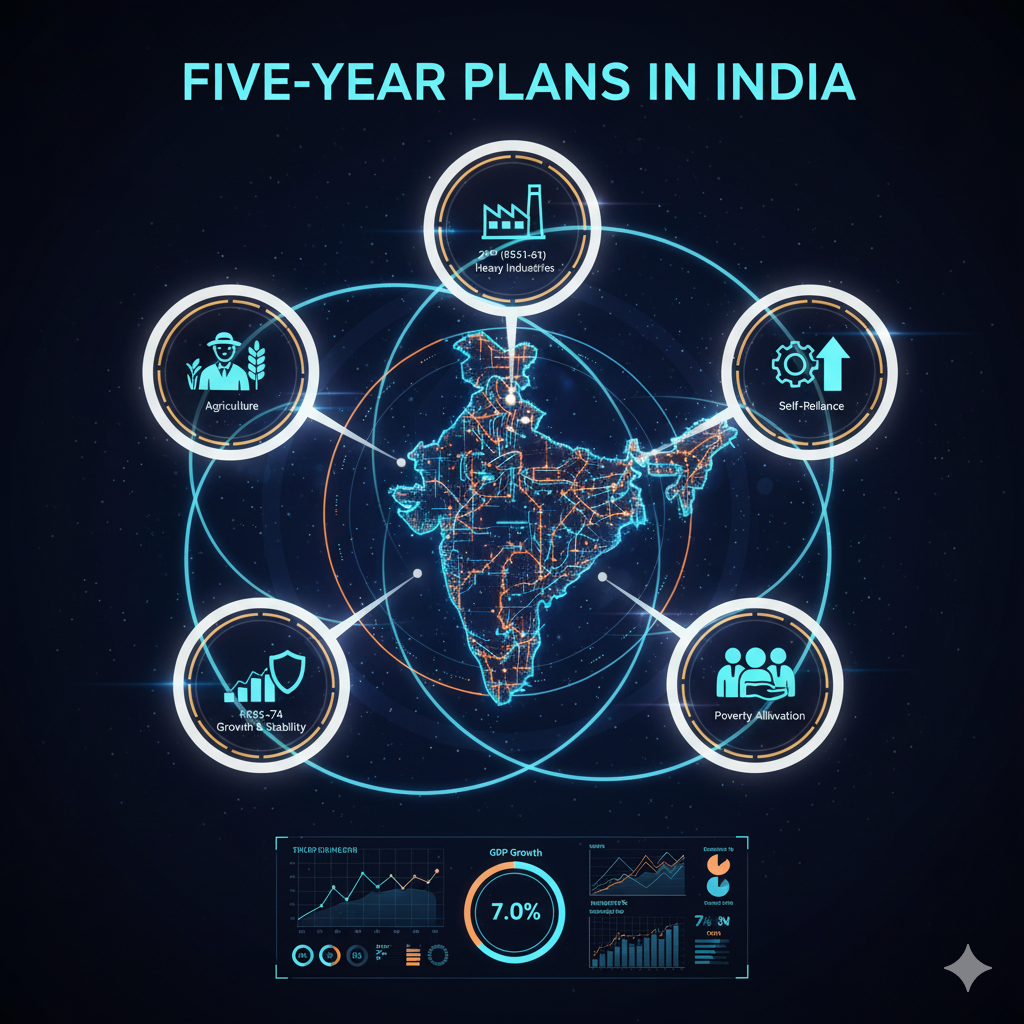Introduction
Economic planning has been the cornerstone of India’s development strategy since independence. After centuries of colonial exploitation, India inherited an economy characterized by poverty, unemployment, low productivity, and regional imbalances. To overcome these challenges and promote rapid development, the Government of India adopted a system of planned economic growth, primarily through a series of Five-Year Plans.
The Five-Year Plans served as blueprints for national development, outlining the country’s priorities, targets, and policy directions. They aimed to mobilize resources effectively, improve living standards, and ensure balanced regional and sectoral growth.
From 1951 to 2017, India implemented twelve Five-Year Plans, each addressing the pressing socio-economic needs of its time. After the dissolution of the Planning Commission in 2014, India transitioned toward a new planning framework under the NITI Aayog, which replaced Five-Year Plans with a 15-Year Vision Document, 7-Year Strategy, and 3-Year Action Agenda.
Meaning and Concept of Five-Year Plans
A Five-Year Plan is a comprehensive government strategy that outlines the country’s developmental goals, sectoral priorities, and resource allocation for a period of five years. It acts as a guiding framework for economic policy and development planning.
In simple terms, it is a roadmap that determines how national resources—such as capital, labor, and natural wealth—will be used to achieve specific objectives like economic growth, poverty reduction, and modernization.
The idea of Five-Year Planning was inspired by the Soviet model of centralized economic planning, which emphasized state-led industrialization and public investment.
Objectives of the Five-Year Plans in India
The major objectives of the Five-Year Plans evolved over time but generally included:
- Economic Growth: To achieve sustained and rapid growth of national income.
- Social Justice: To reduce inequalities in income, wealth, and opportunity.
- Self-Reliance: To minimize dependence on foreign aid and strengthen domestic capabilities.
- Modernization: To introduce modern technology in agriculture, industry, and infrastructure.
- Employment Generation: To create more jobs and reduce unemployment.
- Balanced Regional Development: To bridge the gap between developed and underdeveloped regions.
- Poverty Alleviation: To uplift the weaker sections of society.
Historical Background of Planning in India
The roots of planning in India go back even before independence. Several initiatives and proposals were made to promote planned economic development:
- Visvesvaraya Plan (1934):
- Proposed by Sir M. Visvesvaraya in his book “Planned Economy for India.”
- Suggested a ten-year plan focusing on industrialization and doubling national income.
- National Planning Committee (1938):
- Set up under the chairmanship of Pandit Jawaharlal Nehru by the Indian National Congress.
- It marked the first organized attempt at national planning.
- Bombay Plan (1944):
- Drafted by leading industrialists like J.R.D. Tata, G.D. Birla, and others.
- Proposed state intervention and a target of doubling national income in 15 years.
- People’s Plan (1945):
- Proposed by M.N. Roy; focused on agriculture and rural development with a socialist orientation.
- Proposed by M.N. Roy; focused on agriculture and rural development with a socialist orientation.
- Gandhian Plan (1944):
- Drafted by S.N. Agarwal; emphasized village industries and self-sufficient rural economy.
- Drafted by S.N. Agarwal; emphasized village industries and self-sufficient rural economy.
- Post-Independence Developments:
- After independence, the Planning Commission was established in March 1950.
- The Commission was tasked with formulating national Five-Year Plans, ensuring efficient use of resources for social and economic progress.
History of Five-Year Plans in India
First Five-Year Plan (1951–56):
Objective: Agricultural development and rehabilitation of refugees.
Approach: Harrod-Domar model; focused on irrigation, power, and agriculture.
Major Achievements:
- Food grain production increased.
- Community Development Program launched.
- National Income grew by 3.6% (target: 2.1%).
Second Five-Year Plan (1956–61):
Objective: Rapid industrialization and development of basic industries.
Approach: Nehru-Mahalanobis model emphasizing heavy industries.
Major Achievements:
- Establishment of major industries like steel, coal, and machine tools.
- Growth rate: 4.1% (target: 4.5%).
Limitations: Agricultural sector lagged behind, causing food shortages.
Third Five-Year Plan (1961–66):
Objective: Self-reliance and balanced growth between agriculture and industry.
Achievements:
- Expansion of education and health sectors.
- Green Revolution initiated (mid-1960s).
Challenges: - Indo-China war (1962), Indo-Pak war (1965), and droughts disrupted progress.
- Plan failed; growth rate only 2.4%.
Plan Holidays (1966–69):
Due to economic instability, three Annual Plans were launched focusing on food security and price stability.
Fourth Five-Year Plan (1969–74):
Objective: Growth with stability and self-reliance.
Focus Areas: Agriculture, social justice, and poverty eradication.
Achievements:
- Nationalization of 14 major banks.
- Growth rate: 3.3%.
Challenges: Oil crisis of 1973 increased inflation.
Fifth Five-Year Plan (1974–79):
Objective: Poverty removal (Garibi Hatao) and self-reliance.
Achievements:
- Emphasis on employment and justice.
- Growth rate: 5%.
Note: The plan was terminated a year early by the Janata Government in 1978.
Sixth Five-Year Plan (1980–85):
Objective: Poverty alleviation, modernization, and employment.
Achievements:
- Integrated Rural Development Programme (IRDP) launched.
- Economic growth: 5.4%.
Seventh Five-Year Plan (1985–90):
Objective: Modernization of industries and technology upgradation.
Achievements:
- Focus on education, communication, and self-sufficiency in food grains.
- Growth rate: 6%.
Eighth Five-Year Plan (1992–97):
Objective: Human development post-economic reforms of 1991.
Achievements:
- High growth rate of 6.8%.
- Liberalization, Privatization, and Globalization (LPG) policies introduced.
Focus: Infrastructure, human resource development, and private sector participation.
Ninth Five-Year Plan (1997–2002):
Objective: Growth with equity and social justice.
Achievements:
- Growth rate: 5.4%.
- Priority to agriculture and employment generation.
Tenth Five-Year Plan (2002–07):
Objective: Achieving 8% growth rate and improving human development.
Achievements:
- Actual growth rate: 7.6%.
- Rural development and governance reforms emphasized.
Eleventh Five-Year Plan (2007–12):
Theme: “Faster and More Inclusive Growth.”
Achievements:
- Significant progress in education and health.
- Economic growth averaged 8%.
Twelfth Five-Year Plan (2012–17):
Theme: “Faster, More Inclusive, and Sustainable Growth.”
Focus: Poverty reduction, employment generation, and sustainable development.
Challenges: Global economic slowdown and declining manufacturing growth.
Outcome: The last Five-Year Plan of India.
Implementation of the Five-Year Plans
The Planning Commission was primarily responsible for formulating and implementing Five-Year Plans, but actual implementation depended on multiple agencies:
- Central Government Ministries: Implement national-level schemes and programs.
- State Governments: Responsible for executing state-specific projects under the plan.
- Public Sector Undertakings (PSUs): Carried out industrial and infrastructure projects.
- District and Local Bodies: Implemented grassroots programs like rural employment, education, and health.
- Monitoring and Evaluation:
- The Planning Commission and later the Programme Evaluation Organisation (PEO) regularly assessed plan progress.
- Mid-term appraisals and reviews helped adjust targets and priorities.
- The Planning Commission and later the Programme Evaluation Organisation (PEO) regularly assessed plan progress.
Achievements of the Five-Year Plans
- Economic Growth: India’s GDP grew steadily from 3.5% in the 1950s to over 8% by the 2000s.
- Industrialization: Establishment of steel plants, machine tools industries, and public sector enterprises.
- Agricultural Revolution: The Green Revolution transformed India into a food-surplus country.
- Infrastructure Development: Expansion of roads, railways, power generation, and irrigation networks.
- Education and Health: Literacy rates improved significantly; major public health programs launched.
- Social Justice: Poverty levels reduced and employment programs introduced.
Shortcomings of the Five-Year Plans
- Regional Imbalances: Certain regions remained underdeveloped despite overall growth.
- Implementation Gaps: Bureaucratic delays and corruption affected execution.
- Over-centralization: States had limited autonomy in planning.
- Inadequate Employment: Growth was often jobless in nature.
- Environmental Concerns: Industrialization led to ecological degradation.
- Dependence on Public Sector: Excessive reliance on PSUs led to inefficiency.
End of the Five-Year Plans
By the 2010s, the global and domestic economic environment had changed drastically. With growing market liberalization, the rigid centralized planning model was seen as outdated.
In 2014, the Planning Commission was abolished and replaced by the NITI Aayog (National Institution for Transforming India). Consequently, the Five-Year Plan system was discontinued after the Twelfth Plan (2012–17).
The new approach aimed to promote cooperative and competitive federalism, flexibility, and innovation in policy-making.
The 15-Year Vision Document in Place of the Five-Year Plans
After the discontinuation of Five-Year Plans, the NITI Aayog introduced a new long-term framework for policy planning. This framework consists of three interlinked documents:
- 15-Year Vision Document
- 7-Year Strategy Document
- 3-Year Action Agenda
1. 15-Year Vision Document
The 15-Year Vision Document serves as a long-term blueprint for India’s socio-economic development up to 2030, aligning with the United Nations Sustainable Development Goals (SDGs).
Objectives:
- Set long-term national priorities and development goals.
- Ensure sustainable, inclusive, and environmentally responsible growth.
- Promote innovation, skill development, and digital transformation.
- Strengthen governance, transparency, and accountability.
Focus Areas:
- Employment and entrepreneurship.
- Health and nutrition.
- Education and skill development.
- Infrastructure and urbanization.
- Energy security and sustainability.
- Agriculture and rural transformation.
- Technology and innovation-driven growth.
2. 7-Year Strategy Document
The 7-Year Strategy Document bridges the gap between the 15-Year Vision and the 3-Year Action Agenda. It sets medium-term goals and outlines sector-specific strategies to achieve them.
This strategy provides a roadmap for achieving the targets mentioned in the Vision Document within a manageable time frame.
3. 3-Year Action Agenda
Introduced in 2017, this document details short-term actionable policies that the government should pursue. It serves as a flexible framework that can adapt to changing circumstances and economic realities.
The Action Agenda focuses on:
- Job creation.
- Revamping education and healthcare.
- Reforming taxation and governance systems.
- Boosting manufacturing and exports.
Comparison: Five-Year Plans vs. NITI Aayog Vision Framework
| Aspect | Five-Year Plans | NITI Aayog Vision Framework |
|---|---|---|
| Timeframe | 5 years | 15-year vision, 7-year strategy, 3-year action plan |
| Approach | Centralized planning | Cooperative and competitive federalism |
| Institution | Planning Commission | NITI Aayog |
| Focus | State-led industrialization | Market-friendly, innovation-driven growth |
| Flexibility | Rigid | Adaptive and dynamic |
| Planning Basis | Resource allocation | Outcome-based performance |
| Global Linkage | Domestic focus | Alignment with UN SDGs |
Significance of the New Planning Framework
- Long-Term Perspective: Encourages continuity and consistency in national policies.
- Decentralized Decision-Making: Promotes participation of states and local bodies.
- Outcome-Oriented: Focuses on measurable results instead of expenditure targets.
- Adaptability: Allows modification based on changing domestic and global situations.
- Integration with SDGs: Ensures that India’s development aligns with global sustainability goals.
Conclusion
The Five-Year Plans played a monumental role in shaping modern India. For over six decades, they guided the nation’s economic, social, and infrastructural transformation. From agricultural self-sufficiency to industrial expansion, from poverty reduction to technological advancement, the Five-Year Plans laid the foundation for India’s progress.
However, as the economy evolved and globalization deepened, a more flexible and participatory planning approach became necessary. The 15-Year Vision Document introduced by NITI Aayog symbolizes this transition — from rigid, top-down planning to dynamic, collaborative governance.
India’s future planning framework now emphasizes innovation, sustainability, inclusivity, and adaptability — marking a new era in the nation’s developmental journey toward “Viksit Bharat @ 2047.”




